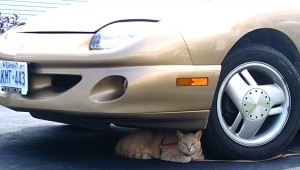As a bicyclist, I have an intimate understanding of how our urban areas in particular are dominated by what I would call ‘car-centrism’. Car-centrism’s chief features include the following three ideas:
- Modern cities are built around infrastructure for cars.
- Roads are considered mostly, if not solely, for cars.
- Automobile drivers have the right to demand of non-drivers both a deference to their convenience as well as a conformity to rules that were designed with them in mind.
 The rising concerns about climate change and alternative transit systems is weakening the strength of this position in many places. However, it’s also true that those of us who regularly walk or bike in many urban areas in North America are still confronted with many difficulties stemming from car-centrism. This includes our four-legged friends.
The rising concerns about climate change and alternative transit systems is weakening the strength of this position in many places. However, it’s also true that those of us who regularly walk or bike in many urban areas in North America are still confronted with many difficulties stemming from car-centrism. This includes our four-legged friends.
A few summers ago, I helped another person try to save a cat in the middle of a busy downtown Minneapolis, Minnesota intersection. That mid-July day I had stepped off my bike onto the sidewalk and was waiting for a light to cross Washington Avenue at 3rd Street. Given how busy the intersection was, I decided it was better to just walk my bike across the crosswalk and then start back-biking on the less-trafficked side street. All of a sudden a cat ran into the street and was hit in its back end by a car. I watched for a moment as, with collapsed hind legs, it tried to run out of traffic to safety. Before the light turned red, I started towards the middle of the intersection, putting my hands in the air. A woman stopped her car, got out and ran towards the cat. I told her I was trying to get the cars to stop and then made my way towards the cat as well. I kept scanning the scene for danger, but mostly saw that the cars were swerving around us or stopping. Finally, we got to the cat. It was bleeding a lot, and still trying to drag itself out of the intersection. The woman had brought a towel so we unfolded it, swooped down, wrapped it around the cat and took it to her car. We thanked each other, commented about the ‘craziness’ of some of the drivers and then she drove off. She planned on taking it to an animal hospital. When she left, the cat was still alive. The whole thing was over in about two minutes.
One thing I later realized was that everything in these kinds of situations feels ramped up. The actions of all players involved, from the cat to the impatient drivers, were heightened and, in memory, probably somewhat exaggerated. No doubt, the cat’s life was in serious danger. In fact, it’s more likely that it died than lived, given the severity of its injuries. In addition, the actions of some of the drivers weren’t terribly helpful. At the same time, they weren’t all that much different from those of drivers under regular conditions, such as when a bicyclist or pedestrian or even another car is ‘in their way’. It’s easier to brush off the same petty, self-absorbed honking when it’s just one person and nothing else traumatic or even dramatic is happening around you. The same action multiplied and added to an already challenging situation, however, can push everything (internally) over the top. It took me hours to come down from the mixture of anger, sadness and adrenaline I felt after helping to rescue the cat. Whereas when I experience the same kind of behavior (honking, impatient swerving etc.) on a smaller scale during my normal bicycle commute, I either brush it off altogether or experience a much less heightened and lengthy reaction.
I’ve come to realize that none of this stuff is ‘personal’ and a lot of it is simply collective dysfunction that is socially sanctioned. It’s just accepted that people have the ‘right’ to the fastest, clearest path – or, that if anyone gets in their way, they can honk, yell at or speed past the offending person, people or animals. This attitude needs to change, and thankfully it’s starting to in many places, but it’s far too slow in my book. I can imagine many of our four-legged friends would agree.
Photo Credits
Catwheels from morgueFile


Please Share Your Thoughts - Leave A Comment!